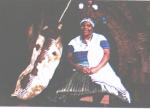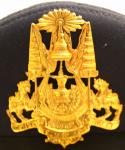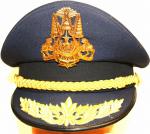-
Posts
13,225 -
Joined
-
Last visited
-
Days Won
22
Content Type
Profiles
Forums
Blogs
Gallery
Events
Store
Everything posted by Mervyn Mitton
-
Hi - Bob. I'm glad you put the explanation for the order of timing for the different symbols. Makes things a little clearer as to how they evolved. I enjoy looking at your posts - but the units can be a little confusing to a non-collector. Mervyn
-

CBP - Homeland Security
Mervyn Mitton replied to Chris Boonzaier's topic in Police Forces of the World
An interesting and unusual badge, Chris. Does the wording and the dual insignia show that they have some authority - or, is it just for identification ? -

Acting Conductor on medal rim
Mervyn Mitton replied to Tony's topic in Great Britain: Orders, Gallantry, Campaign Medals
Just an interesting side note to Peter's answer. The first Thames River Police patrols were in the 1790's and were organised by the West India Company to stop looting of their ships in the West India Docks - (opp. Greenwich). They became the Thames River Police after the Metropolitan Police in 1829. However - each rowing boat had two rowers and a Conductor in charge - I suppose he would have been the equivalent of a sergeant. -

Beret Display
Mervyn Mitton replied to goovernick's topic in Preservation & Restoration of Military Artifacts
Kev's is a good suggestion. An alternative would be to have a specialist shop cut polystyrene shapes that are just high enough to take the beret. Paint them a flesh colour and it will look natural. By the way - welcome to GMIC. -
I mentioned that the Army also had spears for their sentries and other African troops who needed a personal defence weapon. The pattern for this was based entirely on the Zulu Iklwa or, short stabbing spear created by King Shaka back in the 1820's. Vicker's used the same construction and also incorporated the swelling end to the shaft - this was to give grip when pulling it from a body and your hand was probably, covered in blood. The overall length of 4 feet 7 inches is also in accord with the sizes of most iklwas. Why the Army chose this different shape is unknown - perhaps it was thought that a sentry on night patrol would find the shorter version easier to use ? The one I am showing here is the Army version - however, it was chromed and given as a presentation to a retiring General of the Railway Police - back in the 1940's.
-
I usually keep the two Zulu posts well separate - however, with the World attention on Sth. Africa with the soccer , this seems an appropriate time to show these two rare spears. People tend to think that ethnic weaponry is always made by the warriors for fighting and hunting - not so. Back in the 1920's the Government needed weaponry for the Army,Police,and other African men engaged on Govt. duties. This weaponry would have to be uniform in appearance and durability and suitable to be carried by uniformed bodies of men. Having conducted tests, a contract was given to the U.K. firm of Vickers - perhaps better known for their tanks. The reason for requiring a quality, alternative form of weaponry, was quite simply that at that period of time, firearms were not issued to the African soldiers or, police. Vicker's produced a number of spears (umkhontos) in different sizes and shapes - they were heavy stainless steel and had wooden shafts of quality wood. I think they continued supplying until the outbreak of WW2 in 1939 and then Sth. African companies took over. For the police, the African constables - two of whom usually accompanied each white police officer on his patrols - carried a heavy Iwisa (knobkerry) of a standard pattern. However, in times of serious trouble they were issued with a large spear - similar to the one shown - this had a thumb indentation cut into the lower part of the shaft - and always at the same place and angle. They were carried as a rifle would be and were 'sloped' on the left shoulder - with the thumb in the rest, all spears were at the same height and angle - very imposing. When I was living in Durban in the 1950's we had severe rioting in '58 and I actually witnessed 3 platoons of police (100 men) drop their spears from the shoulder to the Present - and then charge 5000 violent people. Who didn't stay to see if the points were sharp.... The Police, Prison Warders and Game Guards all used the longer pattern shown here - each was different only in the shape of the end of the handle - but, all had a butt cap in s/s. They were 4 feet 6 1/2 inches overall(138cm). This was the Game Guards pattern.
-

Seaforth Highlanders Sghian Dubh ~1880's
Mervyn Mitton replied to Hugh's topic in Swords & Edged Weapons
Hugh - few jewellers would deal with cairngorms - they are quite rare. With the quality of the skein dhu - which was of course, carried in the top of the long socks worn with a kilt - I think it was the right one , and worn facing outwards - I feel you can safely assume that it is real. I have also looked again at the metalwork and am fairly sure it is 9ct. gold. This is in keeping with an officer of that period. Does it feel fairly heavy around the metal ? -

Seaforth Highlanders Sghian Dubh ~1880's
Mervyn Mitton replied to Hugh's topic in Swords & Edged Weapons
Hi - Hugh. The dirk could well be earlier then the 1880's - really depends on the Regt. arms. Queen Victoria reigned for so long that sometimes it is only possible to do a general dating. I would say that the 'black' colour of the handle, is what we call 'ebonised' - this was a polish to darken the wood and make it look like ebony. The cairngorm is often a good pointer - they have been using glass for years. Real cairngorms are found in streams and are rare. Your spelling sounds gaelic - would be worth checking ? Mervyn -

Zulu items
Mervyn Mitton replied to helen's topic in Great Britain: Militaria: Badges, Uniforms & Equipment
This is a little different ! Durban opened it's new airport - King Shaka - a few weeks ago. King Shaka was the first King of the Zulu nation and came to the throne in 1816 - the bronze statue was specially commissioned for the forecourt of the airport. The photo was taken at the official opening and shows State President Zuma (left) and King Goodwill Zelathini, the present King. Behind the figure of Shaka are two of the Royal Nguni herd of cattle - also in bronze. King Goodwill took exception to the two bulls and said it made his ancestor look like a 'cow herder' ! They have now been removed and the sculptor is still bewildered - ah ! Africa..... -

Zulu items
Mervyn Mitton replied to helen's topic in Great Britain: Militaria: Badges, Uniforms & Equipment
The skirt being worn by a mature lady. The shield is interesting - it is an Ishilungu - the very large battle shield. Made from the Nguni cattle of the Royal herd they are rare. I wonder on the history of this one ? -

Zulu items
Mervyn Mitton replied to helen's topic in Great Britain: Militaria: Badges, Uniforms & Equipment
-

Zulu items
Mervyn Mitton replied to helen's topic in Great Britain: Militaria: Badges, Uniforms & Equipment
-

Zulu items
Mervyn Mitton replied to helen's topic in Great Britain: Militaria: Badges, Uniforms & Equipment
Some time since we last added to this Zulu thread - and with the World Cup about to start in South Africa it seems the right time. I also have some good spears which I will put on their thread in a short time. This is another good example of a head rest - however, the difference is that it is a marriage gift. As used to happen in Wales, only with spoons, the bridegroom carves the headrest and he and bride each hold one of the half rings - during the ceremony and also in the festivities that follow. With all of these traditional items being discontinued, they now command quite a high price. -
Mike - a very special posting. I knew that a committee had been looking at suggestions but have never seen any pictures. Was this the only one that made it through to a 'mock-up' ? What about the reverse - did they complete both sides ? I must in all honesty say that I am pleased they kept to traditional format - the 'Sheriff's Star' you show is not very attractive. However, thankyou for the opportunity to view. Mervyn
-

Just a Few QSA's
Mervyn Mitton replied to QSAMIKE's topic in Great Britain: Orders, Gallantry, Campaign Medals
Mike - a nice pair. The Canadian Scouts must have been quite small in number ? You will probably find that the sh. flashes ended up on the slouch hats. Many of our local units had them cut out of sheet brass by local jewellers. He must have taken discharge in Sth. Africa to have still been here for the 1906 Bambatha Rebellion - with his previous Scout's service he was just right for the Rangers. -

PART 4 - POLICE FORCES OF THE WORLD
Mervyn Mitton replied to Mervyn Mitton's topic in Police Forces of the World
-

PART 4 - POLICE FORCES OF THE WORLD
Mervyn Mitton replied to Mervyn Mitton's topic in Police Forces of the World
-
Please see 'INTRO' for the additional information we hope to gather on each Force. This cap would appear to be for a high ranking officer - perhaps a general - in the Thai Police.
-

Seaforth Highlanders Sghian Dubh ~1880's
Mervyn Mitton replied to Hugh's topic in Swords & Edged Weapons
Leigh - these are modern ones, made for sale to collector's. They also do Dirks - which are often described as being for bandsmen. However, the quantities made show their real market.

















